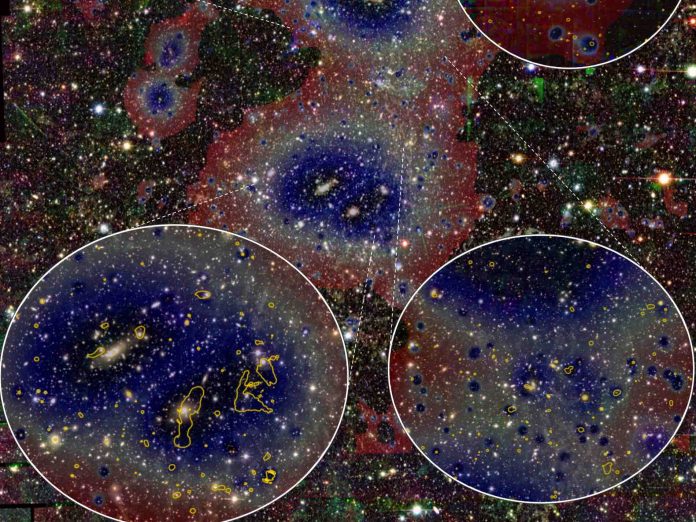Research confirms models on the evolution of our universe.
More than half of the matter in our universe has so far remained hidden from us. However, scientists had a hunch where it might be: In so-called filaments, unfathomably large thread-like structures of hot gas that surround and connect galaxies and galaxy clusters.
“More than half of the matter in our Universe has so far remained hidden from us,” said University of Bonn’s Professor Thomas Reiprich and colleagues.
“However, astrophysicists had a hunch where it might be: in so-called filaments, unfathomably large thread-like structures of hot gas that surround and connect galaxies and galaxy clusters.”
“According to calculations, more than half of all baryonic matter in our Universe is contained in these filaments,” Professor Reiprich added.
“This is the form of matter of which stars and planets are composed, as are we ourselves. Yet it has so far escaped our gaze.”
“Due to the enormous expansion of the filaments, the matter in them is extremely diluted. It contains just 10 particles per m3, which is much less than the best vacuum we can create on Earth.”
“However, with a new measuring instrument, the eROSITA space telescope, we were able to make the gas fully visible for the first time.”
Using eROSITA and ASKAP telescopes, the astronomers observed Abell 3391-Abell 3395, a system of three galaxy clusters located about 700 million light-years away from Earth.
The images revealed not only the clusters and numerous individual galaxies, but also two gas filaments — one of which is 49 million light-years long — that connect the two main portions of the system.
“The new eROSITA images of the observed system resemble remarkably the outcome of our cosmological simulations,” said Dr. Klaus Dolag, an astronomer at the Ludwig-Maximilians-Universität München.
“This suggests that the widely accepted standard model for the evolution of the Universe is correct,” Professor Reiprich added.
“Most importantly, the data show that the missing matter is probably actually hidden in the filaments.”
In the Magneticum computer simulations, the researchers found a very similar pair of galaxy clusters connected by warm gas in a bridge-like filament and surrounded by other objects, aligned in a 49-million-light-year-long filamentary structure.
The simulations confirm that such long filaments contain a substantial amount of diluted gas and extend over large regions of space.
“Our simulations also show that other groups and clusters of galaxies move along the filaments, towards the cosmic web knots such as the one where the Abell 3391-Abell 3395 analog resides,” the scientists said.
“These studies can uniquely help to interpret the origin of the observed pair and filament, and the particular properties of the gas in them.”
“The extremely dilute and colder gas in the filament seems to come from very different directions, almost orthogonal, with respect to the hotter gas within the galaxy clusters,” said Dr. Veronica Biffi, also from the Ludwig-Maximilians-Universität München.
“And the evolution of its properties over the last 10 billion years is also different.”
“These observations of a system of galaxy clusters 700 million light years away from us detect a gaseous filament of the cosmic web, which is thought to pervade the Universe, but has so far eluded our telescopes,” said Professor Ray Norris, an astronomer at Western Sydney University.
“Detecting a gaseous structure on this scale confirmed our model of how the Universe had evolved since the Big Bang,” said Professor Andrew Hopkins, an astronomer at Macquarie University.
“This model, called ‘Lambda Cold Dark Matter’, uses the combination of dark matter and dark energy to explain the way structures in the Universe should appear.”
“This is a great example of two international next-generation telescopes working together to do science that was not possible in the past.”
The findings appear in the journal Astronomy & Astrophysics.





























